Related Research Articles

The Bristol Aeroplane Company, originally the British and Colonial Aeroplane Company, was both one of the first and one of the most important British aviation companies, designing and manufacturing both airframes and aircraft engines. Notable aircraft produced by the company include the 'Boxkite', the Bristol Fighter, the Bulldog, the Blenheim, the Beaufighter, and the Britannia, and much of the preliminary work which led to Concorde was carried out by the company. In 1956 its major operations were split into Bristol Aircraft and Bristol Aero Engines. In 1959, Bristol Aircraft merged with several major British aircraft companies to form the British Aircraft Corporation (BAC) and Bristol Aero Engines merged with Armstrong Siddeley to form Bristol Siddeley.

The Bristol Pegasus is a British nine-cylinder, single-row, air-cooled radial aero engine. Designed by Roy Fedden of the Bristol Aeroplane Company, it was used to power both civil and military aircraft of the 1930s and 1940s. Developed from the earlier Mercury and Jupiter engines, later variants could produce 1,000 horsepower (750 kW) from its capacity of 1,750 cubic inches by use of a geared supercharger.

The Bristol Bulldog is a British Royal Air Force single-seat biplane fighter designed during the 1920s by the Bristol Aeroplane Company. More than 400 Bulldogs were produced for the RAF and overseas customers, and it was one of the most famous aircraft used by the RAF during the inter-war period.

The Bristol F.2 Fighter was a British two-seat biplane fighter and reconnaissance aircraft of the First World War developed by Frank Barnwell at the Bristol Aeroplane Company. It is often simply called the Bristol Fighter, other popular names include the "Brisfit" or "Biff".

The Gloster Grebe was developed by the Gloster Aircraft Company from the Gloster Grouse, and was the Royal Air Force's first post-First World War fighter aircraft, entering service in 1923.

The Boxkite was the first aircraft produced by the British and Colonial Aeroplane Company. A pusher biplane based on the successful Farman III, it was one of the first aircraft types to be built in quantity. As the type was used by Bristol for instruction purposes at their flying schools at Larkhill and Brooklands many early British aviators learned to fly in a Boxkite. Four were purchased in 1911 by the War Office and examples were sold to Russia and Australia. It continued to be used for training purposes until after the outbreak of the First World War.

The Westland Wapiti was a British two-seat general-purpose military single-engined biplane of the 1920s. It was designed and built by Westland Aircraft Works to replace the Airco DH.9A in Royal Air Force service.
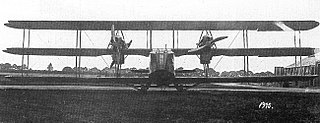
The Bristol Braemar was a British heavy bomber aircraft developed at the end of the First World War for the Royal Air Force. Only two prototypes were constructed.

The Bristol Pullman was a British prototype passenger aircraft developed from the Braemar triplane heavy bomber.
The Bristol Tramp was a British steam-powered passenger and airmail transport aircraft designed by the Bristol Aeroplane Company. It was built but never flew.
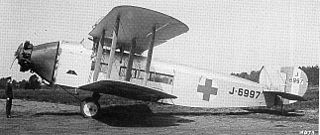
The Bristol Ten-seater and Bristol Brandon were British single-engine biplane transport aircraft built by the Bristol Aeroplane Company in the early 1920s. Only three were built, two of which were used as civil transports and one of which served with the Royal Air Force.

The Bristol Bloodhound was a British two-seat reconnaissance/fighter aircraft designed and built by the Bristol Aeroplane Company as a possible replacement for the Bristol F.2 Fighter for the Royal Air Force. It was unsuccessful, only four prototypes being built.
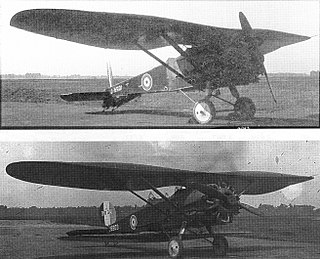
The Bristol Bullfinch was an experimental British military aircraft first flown in 1922. Variants were built as both parasol wing monoplanes and biplanes, but both versions proved unsuccessful, and only the three prototypes were built.

The Bristol Babe was a British-built light single-seat biplane, intended for the private flyer and produced immediately after the First World War. Only two flew.

The Bristol Seely was entered into an Air Ministry competition for safe civil aeroplanes held in 1920. It was a single-engine biplane with accommodation for one passenger. After the competition, the single Seely was used as a testbed for the Bristol Jupiter engine development programme.
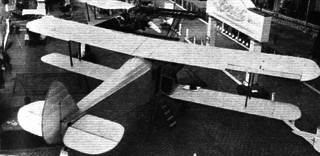
The Bristol Type 110A was a single-engine biplane for charter work, accommodating four passengers in comfort. Designed by Frank Barnwell and built at Filton Aerodrome by the Bristol Aeroplane Company. No orders were obtained and only one aircraft was built.
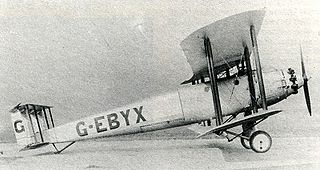
The Vickers Vellore was a large biplane designed as a freight and mail carrier, in single-engined and twin-engined versions, which saw limited use as freighters and long-range experimental aircraft. A final variant with a broader fuselage, the Vellox, was built as an airliner.
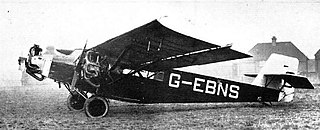
The Handley Page HP.32 Hamlet was a British six-passenger monoplane transport designed and built by Handley Page. Only one was built to order of the Air Ministry, first flown with three-engines, later changed to two then back to three engines.

The Bristol Scout E and F were a British single-seat biplane fighters built in 1916 to use newer and more powerful engines. It was initially powered by the Sunbeam Arab, but the third prototype was used as a testbed for the Cosmos Mercury, marking the start of Roy Fedden's association with the Bristol Aeroplane Company. The Armistice ended hopes of production.

The Fairey Ferret was a 1930s British general-purpose biplane designed and built by the Fairey Aviation Company. It performed well in trials but was not ordered into production.
References
- Notes
- Bibliography
- Barnes C.H. (1988). Bristol Aircraft Since 1910. Putnam & Company Ltd. ISBN 0-85177-823-2.